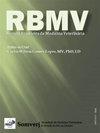Comparative study of the clinical and echodopplercardiographic aspects of left ventricular hypertrophy and hypertrophic cardiomyopathy in cats (Felis catus)
Q4 Veterinary
引用次数: 0
Abstract
The aim of the present study was to differentiate hypertrophic cardiomyopathy (HCM) from concentric left ventricular hypertrophy (CLVH) and to compare their echodopplercardiography measurements in random bred domestic cats. After owners consent cats of any sex or age with no history of heart disease were randomly submitted to physical examination and echocardiogram. When left ventricular hypertrophy was present on the echocardiogram, cats were further examined by chest X-rays, ultrasonography and laboratory work. Those presenting cardiac hypertrophy with the diagnosis of any disease that could cause left ventricular hypertrophy were allocated into one group (CLVH) and those presenting hypertrophy without any concomitant detectable disease were allocated to another group (HCM). Cats with ventricular hypertrophy cats were included (n=10), among which five were classified as secondary CLVH, with hyperthyroidism being the main cause and five characterized as HCM. Considering the diagnosis of concentric ventricular hypertrophy, other diseases should be investigated and ruled out, such as hyperthyroidism. It is also necessary to consider and monitor cardiac changes more closely, since their phenotypic manifestation was severer than those observed in the animals with HCM. However, to determine whether disease progression in these animals is faster severer than in others, further epidemiological studies are necessary.猫左心室肥厚和肥厚型心肌病的临床和超声心动图对比研究
本研究的目的是区分肥厚型心肌病(HCM)和向心性左心室肥大(CLVH),并比较它们在随机饲养的家猫中的超声心动图测量结果。在主人同意后,任何性别或年龄、没有心脏病史的猫都被随机接受体检和超声心动图检查。当超声心动图显示左心室肥大时,猫会通过胸部X光、超声和实验室工作进行进一步检查。诊断为任何可能导致左心室肥大的疾病的心肌肥大患者被分为一组(CLVH),而没有任何可检测疾病的心肌肥厚患者则被分为另一组(HCM)。包括患有心室肥大的猫(n=10),其中5只被归类为继发性CLVH,甲状腺功能亢进是主要原因,5只被定性为HCM。考虑到同心性心室肥大的诊断,应调查并排除其他疾病,如甲状腺功能亢进。还需要更密切地考虑和监测心脏变化,因为它们的表型表现比HCM动物中观察到的更严重。然而,为了确定这些动物的疾病进展是否比其他动物更快、更严重,有必要进行进一步的流行病学研究。
本文章由计算机程序翻译,如有差异,请以英文原文为准。
求助全文
约1分钟内获得全文
求助全文
来源期刊
CiteScore
0.80
自引率
0.00%
发文量
34
审稿时长
>12 weeks
期刊介绍:
The Brazilian Journal of Veterinary Medicine was launched in 1979 as the official scientific periodical of the Sociedade de Medicina Veterinária do Estado do Rio de Janeiro (SOMVERJ). It is recognized by the Sociedade Brasileira de Medicina Veterinária (SBMV) and the Conselho Regional de Medicina Veterinária do Estado do Rio de Janeiro (CRMV-RJ).

 求助内容:
求助内容: 应助结果提醒方式:
应助结果提醒方式:


